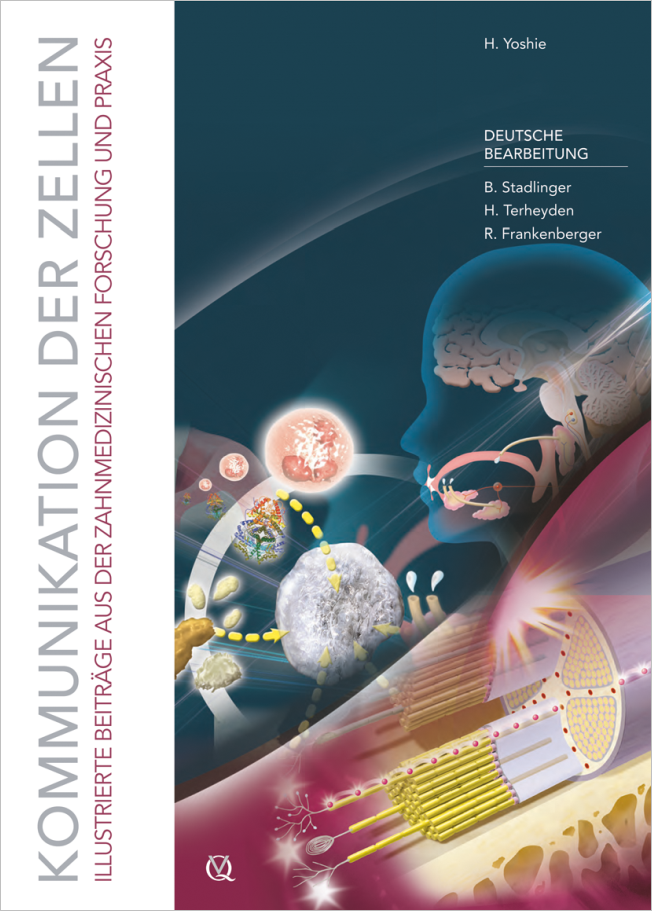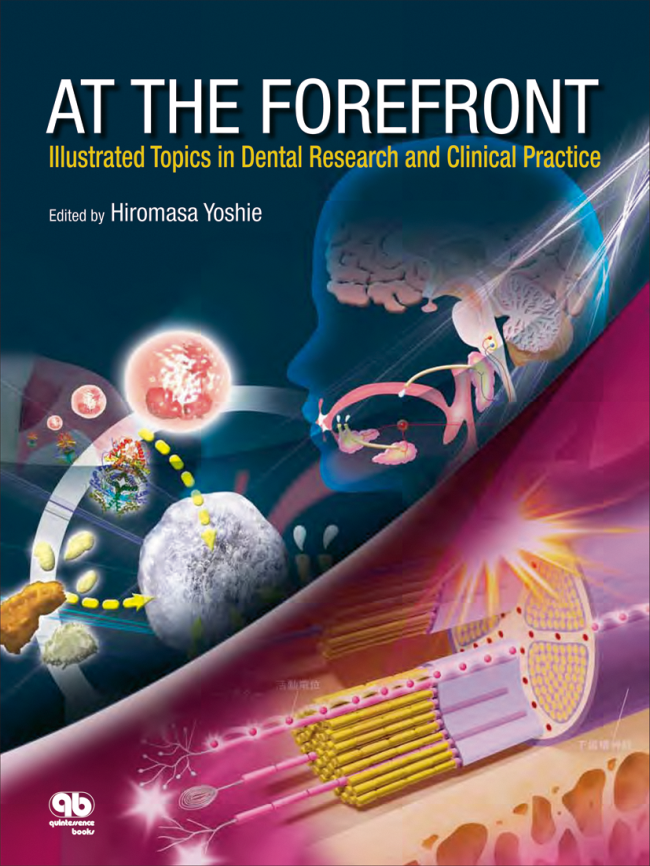International Journal of Periodontics & Restorative Dentistry, 2/2021
Pages 187-192, Language: EnglishYamamoto, Atsuhiko / Kubota, Takehiko / Komatsu, Yasutaka / Nohno, Kaname / Yasuda, Tadashi / Takahashi, Tsurayuki / Torikata, Ryuboku / Tsumori, Norimasa / Shibutani, Toshiaki / Umeda, Makoto / Yoshie, HiromasaThis paper reports on a study undertaken to ascertain the efficacy of the erbium:YAG laser (EYL) for peri-implantitis treatment. A total of 12 patients with bone loss resulting from peri-implantitis were involved in this study. The treatment protocol consisted of using the EYL for implant surface debridement and deproteinized bovine bone mineral (DBBM) for bone grafting. The following parameters were analyzed: probing pocket depth (PPD), clinical attachment level (CAL), bleeding on probing (BOP), bone levels (BLs), and the lipopolysaccharide levels before and after debridement with the EYL. This study found a statistically significant improvement in PPD, CAL, BOP, and BL at 3 and 12 months postoperative. Furthermore, a statistically significant decrease in implant-surface LPS levels was observed following debridement with the EYL. These findings show that using the EYL for debridement in peri-implantitis cases is effective in decreasing LPS levels. Moreover, after partial reconstruction with DBBM grafting, BLs were restored for at least 12 months. It was shown in one case that BLs had remained stable over 6 years, which also attests to the efficacy of this treatment. The combined use of EYL and DBBM could be effective for regenerative surgical peri-implantitis treatment.
International Journal of Periodontics & Restorative Dentistry, 3/2018
DOI: 10.11607/prd.3288, PubMed ID (PMID): 29641626Pages 373-381, Language: EnglishNemoto, Yasuko / Kubota, Takehiko / Nohno, Kaname / Nezu, Arata / Morozumi, Toshiya / Yoshie, HiromasaUse of collagen membrane (CM) with deproteinized bovine bone mineral (DBBM) and enamel matrix derivative (EMD) in periodontal regenerative therapy was evaluated. A total of 40 intrabony defects in periodontitis patients were treated. Clinical parameters and filled bone volume (FBV) and rate (FBR) were assessed. Probing pocket depth (PPD) was reduced significantly at 12 months with CM treatment, while clinical attachment level (CAL), FBV, and FBR showed similar improvements. In stratified analyses, CM-treated thick-biotype patients showed significant improvement in PPD and CAL. Regenerative therapy with the use of EMD and DBBM showed similar improvements in periodontal tissue regeneration with or without CM. The combination with CM appeared to influence the healing of soft tissue and was effective in decreasing pocket depth.
International Journal of Periodontics & Restorative Dentistry, 3/2013
DOI: 10.11607/prd.1545, PubMed ID (PMID): 23593621Pages 281-287, Language: EnglishOkuda, Kazuhiro / Kawase, Tomoyuki / Nagata, Masaki / Yamamiya, Kanoko / Nakata, Koh / Wolff, Larry F. / Yoshie, HiromasaOne-year data after autologous grafting of infrabony periodontal defects with human cultured periosteum sheets in combination with platelet-rich plasma and hydroxyapatite granules have shown favorable clinical and radiographic results. A 5-year follow-up evaluation of 22 selected patients indicated that treated infrabony defects remained stable. Radiographically, there was an increase in osseous radiopacity and bone trabeculation suggesting further bone maturation. This novel tissue-engineered periodontal treatment approach has resulted in significant clinical improvement, and defects remained stable after 5 years.
International Journal of Periodontics & Restorative Dentistry, 5/2008
PubMed ID (PMID): 18990997Pages 461-467, Language: EnglishMurata, Masashi / Okuda, Kazuhiro / Momose, Manabu / Kubo, Kentarou / Kuroyanagi, Yoshimitsu / Wolff, Larry F. / Yoshie, HiromasaCultured gingival dermal substitute (CGDS), composed of gingival fibroblasts and matrix and fabricated using tissue-engineering techniques, has been used for root coverage procedures. Fourteen sites from four patients with >= 2 mm of Miller Class I or II facial gingival tissue recession were treated. The autologous CGDS sheet, prepared prior to surgical treatment, was grafted over the teeth with gingival recession and then covered with a coronally positioned flap. Vertical and horizontal recession was measured at baseline (prior to the surgical procedure) and 13 to 40 weeks (average: 30.7 ± 9.6 weeks) after surgery. The average vertical and horizontal root coverage after surgery was 79.1% ± 25.7% and 75.2% ± 31.4%, respectively. Moreover, there was a significant increase of keratinized and attached gingival tissue at the final clinical evaluation compared with preoperative measurements (P .05). These results demonstrate CGDS as a promising grafting material for use with root coverage procedures in periodontal therapy.
International Journal of Periodontics & Restorative Dentistry, 2/2004
Pages 119-125, Language: EnglishOkuda, Kazuhiro/Momose, Manabu/Murata, Masashi/Saito, Yoshinori/Inoie, Masukazu/Shinohara, Chikara/Wolff, Larry F./Yoshie, HiromasaHuman cultured gingival epithelial sheets were used as an autologous grafting material for regenerating gingival tissue in the maxillary left and mandibular right quadrants of a patient with chronic desquamative gingivitis. Six months postsurgery in both treated areas, there were gains in keratinized gingiva and no signs of gingival inflammation compared to presurgery. In the maxillary left quadrant, preoperative histopathologic findings revealed the epithelium was separated from the connective tissue and inflammatory cells were extensive. After grafting with the gingival epithelial sheets, inflammatory cells were decreased and separation between epithelium and connective tissue was not observed. The human cultured gingival epithelial sheets fabricated using tissue engineering technology showed significant promise for gingival augmentation in periodontal therapy.





